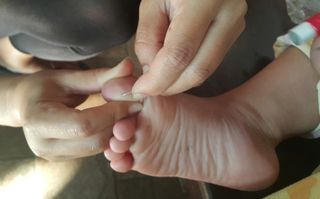What Happens If A Splinter Stays In Your Skin
What Happens If You Don't Take Out a Splinter?

It can be a freeing feeling to shuck off your shoes and walk outside barefoot during the warm spring and hot summer, until the deck sticks your exposed foot with a tiny, pointy souvenir: a splinter.
Simply it's so tiny or so deeply stuck in the skin that you can't become information technology out. So, what would happen if you only left it in?
It's best not to wait and see, as leaving a splinter in the trunk can provide a passageway for infection, said Ashley Jones, a certified nurse practitioner at The Ohio Land University Wexner Medical Center. [Do Rusty Nails Really Give You Tetanus?]
The "skin is a physical barrier that prevents infections," Jones told Live Science. So a splinter that breaks that skin "makes it easier for bacteria outside of the skin to actually get under the peel." That leaner may already be on the splinter, holding on for a complimentary ride into the bloodstream, or it may brand its way in through the open gates subsequently the incursion.
One such infection is caused by the tetanus leaner (clostridium tetani), which, if it makes its manner into the torso of a person who is not vaccinated or up to engagement on their tetanus boosters, can release toxins that harm the nervous system.
Because of the risk of infection, "I would generally recommend that you lot not exit a splinter in place," Jones said. If you can't hands grab it with tweezers and by applying a wearisome, steady pressure, "I would recommend just seeking health care," she said.
Dr. Jefry Biehler, chair of pediatrics at Nicklaus Children'south Hospital in Miami, echoed this recommendation. If removing a deeply embedded splinter at home may result in a lot of bleeding, then head to a health care center, where professionals can remove the splinter using clean, sterile instruments, he said.
If the splinter isn't removed, the body probably won't absorb the invader or suspension information technology down. Rather, the body volition probable endeavor to push button the splinter out, Biehler said. The splinter may cause an inflammatory reaction, which could mean swelling and redness in that surface area. What's more, pockets of pus may class to help expel the splinter.
If the inflammatory response continues for a number of days or weeks, the area tin sometimes develop a somewhat permanent bump or what's called a "granuloma," Jones added. This is kind of a protective bubble of immune cells that surround the strange object the trunk wasn't able to oust.
Sometimes the torso tin can naturally expel a splinter from the skin without causing an inflammatory response, Biehler said. Other times, the splinter may stay in the skin forever.
Biehler noted that one of his nurse friends has had an inch-long thorn in her hand for the past 40 years. "You can experience it, she can move it … [simply] information technology doesn't crusade her any pain," he said. "She'south been fine for 40 years." The splinter doesn't carry every bit large of a risk of infection as when she first got it, because the pare closed on meridian of it, he added.
"Information technology is a fine line between what needs to exist seen [by a medico], what needs to be removed and what can be left alone," Biehler said. But in general, splinters you get around the house or those that come from plant materials, such as wood, "usually demand to come out, considering the body reacts to it."
In any case, strange bodies lodged in the skin — especially in children and the elderly, who may exist more decumbent to infections — should exist evaluated past a health intendance professional, he said.
- Why Practise Our Fingernails Keep Growing Until the Day We Die?
- Does Medicine Really Expire?
- Practise You Really Need to Buy Aluminum-Free Deodorant?
Originally published on Live Science .
Source: https://www.livescience.com/65710-should-you-always-remove-splinters.html
Posted by: mooreressuffe1953.blogspot.com


0 Response to "What Happens If A Splinter Stays In Your Skin"
Post a Comment